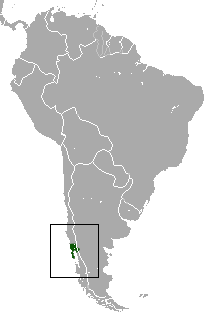Long-nosed caenolestid facts for kids
Quick facts for kids Long-nosed caenolestid |
|
|---|---|
| Conservation status | |
| Scientific classification | |
| Genus: |
Rhyncholestes
|
| Species: |
raphanurus
|
| Subspecies | |
|
R. r. continentalis Bublitz, 1987 |
|
 |
|
| Range of the long-nosed caenolestid | |
The long-nosed caenolestid (Rhyncholestes raphanurus) is a small animal that looks a bit like a shrew or an opossum. It's also called the Chilean shrew opossum. This unique creature lives in cool, wet forests in Argentina and southern Chile.
It has a long, pointy nose, tiny eyes and ears, and thin legs with one claw on each toe. Not much is known about how it lives, but scientists think it stays on the ground and is mostly active at night. It eats both plants and animals, making it an omnivorous creature. The long-nosed caenolestid is currently listed as near threatened by the IUCN, which means its population needs to be watched carefully.
Contents
About the Long-Nosed Caenolestid
The long-nosed caenolestid is the only animal in its group, called Rhyncholestes. It belongs to the family Caenolestidae. An American zoologist named Wilfred Hudson Osgood first described this animal in 1924.
There are two types, or subspecies, of the long-nosed caenolestid:
- R. r. continentalis: This one lives in parts of Argentina and Chile.
- R. r. raphanurus: This one is found on southern Chiloé Island, which is off the coast of Chile.
Scientists have studied the body features and DNA of these animals. They found that the long-nosed caenolestid is closely related to the Incan caenolestid. Both are part of a larger group that includes other Caenolestes species.
The name Rhyncholestes comes from Greek words. Rhynchos means "snout," and lestes means "robber" or "pirate." The second part of its scientific name, raphanurus, comes from the Greek word for "cabbage." This refers to its thick tail. In Spanish, it's called comadrejita trompuda, which means "little weasel with a snout."
What Does It Look Like?
The long-nosed caenolestid looks similar to other Caenolestes species. In 1924, Wilfred Hudson Osgood measured some of these animals. Their body length, from head to tail, was about 17.5 to 21.5 centimeters (7 to 8.5 inches). Their skulls were about 3 to 3.5 centimeters (1.2 to 1.4 inches) long.
This animal has smooth, dark grayish-brown fur. Its fur is the same color all over, without lighter or darker areas. It has a long, pointed snout, small eyes, and small ears. Its limbs are thin, and each toe has a single claw.
Unlike many other marsupials, the long-nosed caenolestid does not have a pouch to carry its young. Instead, the babies attach directly to their mother's nipples. It has seven nipples, which is more than the four nipples usually found on other caenolestids.
Its tail helps it balance when it moves. Because its tail is shorter than some other caenolestids, it might not be as quick or agile. The tail can also store fat, and it's often thickest during the early winter months.
The long-nosed caenolestid has teeth that look a bit like a rodent's. Its front teeth, called incisors, help it catch small animals and find insects in cracks.
How It Lives
We don't know a lot about the daily life of the long-nosed caenolestid. It seems to live on land, which means it's a terrestrial animal. It's also nocturnal, meaning it's most active at night.
As an omnivore, it eats a variety of foods. Its diet includes insects and other small invertebrates. It also eats plant material, like fungi.
These caenolestids seem to live in burrows or inside fallen logs. They might use temporary nests for shelter. Baby caenolestids have been seen with their mothers in May, and also from October to March.
Where It Lives and Its Status
The long-nosed caenolestid makes its home in the temperate forests of Argentina and southern Chile. It can be found at heights up to 1,135 meters (3,724 feet) above sea level in places like Osorno Province, Chile. It prefers cool, damp areas.
This animal is found in fewer than 25 different places, meaning it has a very small living area. It also lives at the southernmost edge of where caenolestids are found. Even though there might be many of them in certain spots, their survival is at risk because of deforestation. This is when forests are cut down.
Since the 1990s, the number of long-nosed caenolestids has dropped by almost 20%. This decline is mainly due to forests being cut down and more human settlements. Because of these threats, the IUCN has classified the long-nosed caenolestid as near threatened. This means it's not in immediate danger, but its population needs to be watched closely to make sure it doesn't become endangered.
See also
 In Spanish: Comadrejita trompuda para niños
In Spanish: Comadrejita trompuda para niños


